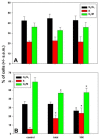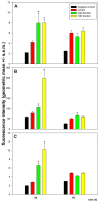Cytotoxic Potential of the Coelomic Fluid Extracted from the Sea Cucumber Holothuria tubulosa against Triple-Negative MDA-MB231 Breast Cancer Cells
- PMID: 31600896
- PMCID: PMC6955747
- DOI: 10.3390/biology8040076
Cytotoxic Potential of the Coelomic Fluid Extracted from the Sea Cucumber Holothuria tubulosa against Triple-Negative MDA-MB231 Breast Cancer Cells
Abstract
Growing evidence has demonstrated that the extracts of different holothurian species exert beneficial effects on human health. Triple negative breast cancers (TNBC) are highly malignant tumors that present a poor prognosis due to the lack of effective targeted therapies. In the attempt to identify novel compounds that might counteract TNBC cell growth, we studied the effect of the exposure of the TNBC cell line MDA-MB231 to total and filtered aqueous extracts of the coelomic fluid obtained from the sea cucumber Holoturia tubulosa, a widespread species in the Mediterranean Sea. In particular, we examined cell viability and proliferative behaviour, cell cycle distribution, apoptosis, autophagy, and mitochondrial metabolic/cell redox state. The results obtained indicate that both total and fractionated extracts are potent inhibitors of TNBC cell viability and growth, acting through both an impairment of cell cycle progression and mitochondrial transmembrane potential and a stimulation of cellular autophagy, as demonstrated by the increase of the acidic vesicular organelles and of the intracellular protein markers beclin-1, and total LC3 and LC3-II upon early exposure to the preparations. Identification of the water-soluble bioactive component(s) present in the extract merit further investigation aiming to develop novel prevention and/or treatment agents efficacious against highly metastatic breast carcinomas.
Keywords: Holothuria tubulosa; autophagy; breast cancer; cell cycle; cell viability; coelomic fluid; mitochondrial function.
Conflict of interest statement
The authors declare no conflict of interest.
Figures








References
-
- Mamelona J., Pelletier E.M., Lalancette K.G., Legault J., Karboune S., Kermasha S. Quantification of phenolic contents and antioxidant capacity of Atlantic sea cucumber, Cucumaria frondosa. Food Chem. 2007;104:1040–1047. doi: 10.1016/j.foodchem.2007.01.016. - DOI
-
- Chen J. Overview of sea cucumber farming and sea ranching practices in China. SPC Beche-de-mer Inf. Bull. 2003;18:18–23.
Grants and funding
LinkOut - more resources
Full Text Sources
Miscellaneous

